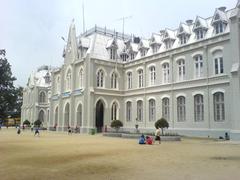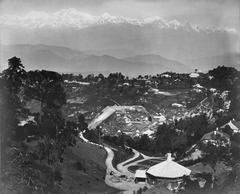Mahakal Temple Darjeeling: Visiting Hours, Tickets, and Comprehensive Travel Guide
Date: 15/06/2025
Introduction
Perched atop Observatory Hill, the Mahakal Temple is one of Darjeeling’s most revered spiritual, historical, and cultural landmarks. Uniquely embodying the coexistence of Hindu and Buddhist faiths, the temple draws pilgrims, history lovers, and travelers seeking both religious insight and panoramic Himalayan vistas. Originally the site of the Dorje Ling Monastery in the 18th century, Mahakal Temple’s rich history and syncretic traditions continue to inspire awe and reverence (kaalchakra.in; darjeelinghills.com).
This guide covers Mahakal Temple’s historical evolution, architectural highlights, visitor information (including hours, entry, and accessibility), nearby attractions, and essential travel tips—ensuring an enriching visit to this extraordinary Darjeeling site.
Historical Background and Religious Significance
Early Origins and Syncretism
Observatory Hill’s sacredness predates both Hindu and Buddhist presence, originally venerated by the indigenous Lepcha community. In 1765, Lama Dorjey Rinzing founded the Dorje Ling Monastery here, giving Darjeeling its name and establishing the site as a Buddhist spiritual center (travelsetu.com).
After the Gurkha invasion in 1788, the monastery was destroyed. According to legend, three Shiva Lingas—representing Brahma, Vishnu, and Maheshwar—manifested miraculously on the site, transforming it into a major Hindu pilgrimage destination (darjeelingadventuretourism.com). The Buddhist monastery was subsequently relocated to Bhutia Busty, while the hilltop evolved into a temple complex that still honors both traditions (kaalchakra.in).
A Center of Religious Harmony
Today, Mahakal Temple remains a rare example of religious coexistence. Hindu priests and Buddhist monks perform rituals side by side; the sanctum houses both Shiva Lingas and Buddha idols, and the grounds are adorned with both prayer flags and temple bells. This duality is not just symbolic—daily aartis, pujas, and Buddhist chants are conducted together, fostering a unique spirit of mutual respect and unity (dharma.werindia.com; thrillophilia.com).
Cultural Importance
The Mahakal Temple is central to Darjeeling’s identity, drawing thousands during major festivals like Maha Shivaratri and Buddha Jayanti. Its history, legends, and living traditions make it a vibrant symbol of the region’s pluralism and resilience (travelsetu.com).
Architectural Features and Temple Layout
Syncretic Design
The main temple follows a circular Hindu architectural plan and is constructed from stone and wood, reflecting local building traditions (OmAstrology). The sanctum houses three gold-plated Shiva Lingas and Buddha statues, while smaller shrines honor deities such as Kali, Durga, Ganesha, Hanuman, and Shirdi Sai Baba (Wikipedia).
Entrance and Pathways
Visitors approach via a picturesque, uphill path from Chowrasta Mall, lined with hundreds of fluttering Buddhist prayer flags and rows of temple bells. A prominent statue of Nandi, Shiva’s bull, marks the entrance (OmAstrology). Benches and rest stops are available along the way (Honeymoon Bug).
Sacred Cave and Chorten
A sacred meditation cave situated near the summit is revered by both Hindus and Buddhists. The site also features a white chorten containing the relics of Lama Dorjey Rinzing, further emphasizing the temple’s multicultural character (RoadsRider).
Decorative Elements
The temple is renowned for an abundance of prayer flags, temple bells, intricate wooden carvings, and colorful paintings, all set against a lush forested backdrop and the panoramic Himalayas (Poojn.in).
Visiting Information
Visiting Hours
- General Hours: Open every day from 6:00 AM to 8:00 PM (kaalchakra.in; thrillophilia.com).
- Seasonal Variations: Some sources note extended hours, from 4:00 AM to 11:00 PM, especially during peak pilgrimage times (traveltriangle.com).
Entry and Tickets
- Entry Fee: There is no entry fee; donations are welcome for temple maintenance.
- Guided Tours: Local guides are available for hire in Darjeeling; guided packages may include the temple and other historical sites (theindosphere.com).
Accessibility
- Approach: Reachable only by foot via a gentle uphill walk (10–15 minutes) from Darjeeling’s Mall Road (Wikipedia).
- Mobility: The path includes stairs and may be challenging for visitors with mobility issues. Benches are provided for rest, but there are no ramps or lifts.
- Facilities: Basic restrooms and small offering stalls are available near the temple.
Best Time to Visit
- Season: April to June is ideal for clear views and pleasant weather.
- Daytime: Early mornings offer a tranquil atmosphere and stunning sunrises over the Himalayas.
Rituals, Festivals, and Visitor Participation
Daily and Special Rituals
- Hindu Worship: Daily aartis and pujas, with special emphasis on Mondays.
- Buddhist Practices: Monks chant mantras, spin prayer wheels, and hang prayer flags.
- Shared Ceremonies: Both faiths participate in major festivals, such as Maha Shivaratri (night-long prayers) and Buddha Jayanti (with butter lamps and chanting) (darjeelinghills.com).
Visitor Participation
- Offerings: Purchase flowers, incense, and sweets from nearby stalls.
- Meditation: Designated quiet areas are available for meditation.
- Etiquette: Dress modestly (cover shoulders and knees), remove footwear before entering, and maintain respectful silence. Photography may be restricted in some areas.
Nearby Attractions and Suggested Itinerary
- Bhutia Busty Monastery: Continues the Buddhist legacy, located about a mile away.
- Darjeeling Himalayan Railway: UNESCO-listed toy train, within walking distance.
- Mall Road: Shops, cafés, and local markets near the temple.
- Japanese Peace Pagoda: 2 km away; accessible by taxi or a scenic walk.
- Tiger Hill: Famous for sunrise views of Kanchenjunga.
Suggested itinerary: Early morning temple visit, breakfast at a nearby café, and then exploring Mall Road and surrounding attractions.
Practical Travel Tips
- Arrive Early: For peaceful worship and panoramic sunrise views.
- Weather: Carry a jacket or umbrella due to rapidly changing weather.
- Footwear: Comfortable shoes for the climb (to be removed inside the temple).
- Safety: Beware of monkeys and keep valuables secure.
- Hydration: Bring water, as the climb can be physically demanding.
- Responsible Tourism: Avoid littering, support local vendors, and respect the tranquil environment.
Frequently Asked Questions (FAQs)
Q: What are Mahakal Temple’s visiting hours?
A: Generally from 6:00 AM to 8:00 PM; may extend from 4:00 AM to 11:00 PM during festivals.
Q: Is there an entry fee?
A: No, entry is free; donations are welcome.
Q: How do I reach the temple?
A: By foot via a short uphill walk from Darjeeling’s Mall Road.
Q: Are guided tours available?
A: Yes, local guides and tour packages include the temple.
Q: Is the temple accessible for differently-abled visitors?
A: The path is steep and has steps; assistance may be needed.
Q: Which festivals are celebrated here?
A: Maha Shivaratri, Durga Puja, Ganesh Puja, Saraswati Puja, and Buddha Jayanti.
Visuals and Additional Resources
- Include images of Mahakal Temple’s entrance, sanctum, prayer flags, and panoramic Himalayan views.
- Embed a map for directions: Google Maps - Mahakal Temple.
- Add a short video of daily rituals and interfaith ceremonies for an immersive experience.
Summary and Visitor Recommendations
Mahakal Temple is a living symbol of Darjeeling’s religious and cultural plurality. Its storied past, architectural elegance, and unique interfaith rituals make it one of the region’s most essential historical sites (darjeelingadventuretourism.com; Wikipedia). With free entry, accessible hours, and close proximity to other attractions, it offers a culturally rich and contemplative experience.
Plan your visit to Mahakal Temple for an authentic encounter with Darjeeling’s spiritual heart. Download the Audiala app for more guides, tour recommendations, and up-to-date festival information to make your Himalayan journey unforgettable.
Sources and Further Reading
- Mahakal Temple Darjeeling: Visiting Hours, Tickets & Historical Sites Guide, 2025, Kaalchakra.in
- Visiting Mahakal Temple, Darjeeling: Religious Significance, Visiting Hours, and Tourist Guide, 2025, Darjeeling Hills
- Mahakal Temple Darjeeling: Visiting Hours, Tickets, and Historical Guide, 2025, Wikipedia & OmAstrology
- Mahakal Temple Visiting Hours, Tickets, and Guide to Darjeeling’s Historic Site, 2025, The IndoSphere
- Mahakal Temple, Darjeeling Historical and Cultural Guide, 2025, TravelSetu
- Darjeeling Adventure Tourism, 2025, Darjeeling Adventure Tourism
- Mahakal Temple Timings and Visitor Information, 2025, TravelTriangle
- Thrillophilia Mahakal Mandir Overview, 2025, Thrillophilia




